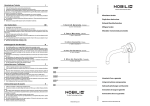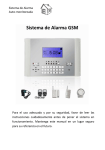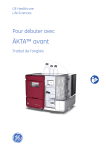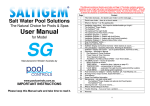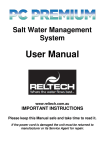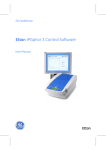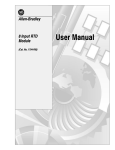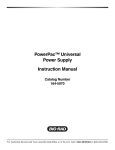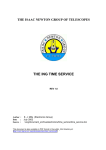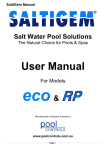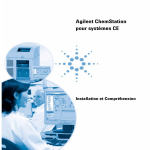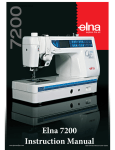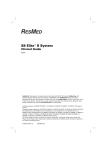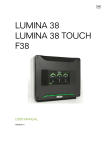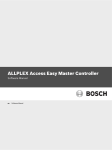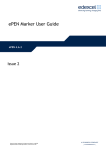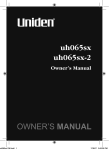Download IPGphor Isoelectric Focusing System User Manual
Transcript
A M E R S H A M P H A R M A C I A B I O IPGphor Isoelectric Focusing System User Manual 80-6415-35/Rev. A1/11-00 T E C H I P G p h o r I s o e l e c t r i c F o c u s i n g S y s t e m U s e r M a n u a l 1. IPGphor Function and Description 1.1. Unpacking . . . . . . . . . . . . . . . . . . . . . . . . . . . . . . . . . . . . . . . . . . . . . . . . . . . . . . . . . . . . . . . . . . . 2 . . . . . . . . . . . . . . . . . . . . . . . . . . . . . . 4 . . . . . . . . . . . . . . . . . . . . . . . . . . . . . . . . . . . 6 1.2. Instrument components . 1.3. Important information . 1.4. Specifications . 1 2. Instrument Set Up 2.1. Placing the instrument. 2.2. Power connection . . . . . . . . . . . . . . . . . . . . . . . . . . . . . . 7 . . . . . . . . . . . . . . . . . . . . . . . . . . . . . . . . . 7 . . 7 . . . . . . . . . . . . . . . . . . . . . . . . . . . . . . . . . . . . . . 8 2.3. Optional: Serial port connector for a printer or computer connection 3. Operating Instructions 3.1. Power up . 3.2. Creating and editing protocol programs . . . . . . . . . . . . . . . . . . . . 9 3.2.1. Protocol parameters 3.2.2. Editing protocol parameters 3.2.3. Naming a protocol 3.3. IPG strip rehydration and sample application: IPGphor Cup Loading Strip Holder . . . . . . . . . . . . . . . . . . . . . . 15 3.4. IPG strip rehydration and sample application: Fixed-length IPGphor Strip Holder. . . . . . . . . . . . . . . . . . . . . . . 16 . . . . . . . . . . . . . . . . . . . . . . . . . . . . . . . 18 3.5. Running a protocol . 3.5.1. 3.5.2. 3.5.3. 3.5.4. Final assembly Starting isoelectric focusing Pausing or stopping a protocol Printing a log of instrument conditions 4. Care and Maintenance 4.1. Important! 4.2. Cleaning . . . . . . . . . . . . . . . . . . . . . . . . . . . . . . . . . . . . . 22 . . . . . . . . . . . . . . . . . . . . . . . . . . . . . . . . . . . . . . 22 . . . . . . . . . . . . . . . . . . . . . . . . . . . . . . . . . 23 . . . . . . . . . . . . . . . . . . . . . . . . . . . . . . . . . . . 24 4.3. Replacing fuses . 5. Troubleshooting 6. Customer Service Information 6.1. Technical service and repair . . . . . . . . . . . . . . . . . . . . . . . . . . . 25 . . . . . . . . . . . . . . . . . . . . . . . . . . . . . . 25 . . . . . . . . . . . . . . . . . . . . . . . . . . . . . . . 27 6.2. Ordering information . Protocol Worksheets . A m e r s h a m P h a r m a c i a B i o t e c h i I P G p h o r I s o e l e c t r i c Renseignements importants d’utilization F o c u s i n g S y s t e m U s e r Wichtige Benutzerinformationen Français Für ein vollständiges Verständnis und eine sichere Handhabung dieses Produktes ist es notwendig, daß der Benutzer dieses Handbuch vollständig durchliest. Pour une bonne compréhension et une utilisation en sécurité maximale, il convient de lire entièrement ce manuel. Le symbole de l’éclair dans un triangle équilatéral a pour objet d’attirer l’attention de l’utilisateur sur un danger d’exposition à la haute tension. M a n u a l Deutsch Ein Blitzsymbol in einem gleichseitigen Dreieck soll den Benutzer auf die Gefahr anliegender Hochspannungen hinweisen. Amersham Pharmacia Biotech se réserve le droit d’effectuer des modifications de ces spécifications sans aucun préavis. Wenn Sie Anmerkungen zu diesem Handbuch haben, dann senden Sie diese bitte an: Amersham Pharmacia Biotech, Inc. Marketing Department 654 Minnesota Street San Francisco, CA 94107 USA Amersham Pharmacia Biotech behält sich das Recht vor, die Spezifikationen ohne vorhergehende Ankündigung zu ändern. Garantie et responsabilité Gewährleistung and Haftung Amersham Pharmacia Biotech garantit à l’utilisateur que le produit livré a subi avec succès tous les essais prévus pour s’assurer qu’il est conforme aux spécifications et normes en vigueur. La garantie incluse dans les conditions de livraison n’est valable que si le produit a été installé et utilisé conformément aux instructions fournies par Amersham Pharmacia Biotech. Amersham Pharmacia Biotech garantiert, daß das gelieferte Produkt sorgfältig auf die Einhaltung der veröffentlichten Spezifikationen getestet wurde. Die in den Lieferbedingungen näher erläuterten Gewährleistungsansprüche gelten nur dann, wenn das Produkt gemäß den von Amersham Pharmacia Biotech gelieferten Anweisungen installiert und benutzt wurde. La société Amersham Pharmacia Biotech ne sera en aucun cas responsable de tout dommage causé directement ou indirectement par toute utilisation incorrecte ou non approuvée du produit ou découlant de cette utilisation, y compris toute perte de bénéfice ou de recettes, toute perte de perspectives commerciales, tout empêchement d’utilisation et tout autre risques ayant un rapport avec l’utilisation du produit, mais sans aucune limitation quant à la nature de ces dommages. Amersham Pharmacia Biotech übernimmt keinerlei Haftung für Schäden oder Folgeschäden, einschließlich, aber nicht begrenzt auf Gewinneinbußen, Einkommensverluste, entgangene Geschäftsabschlüsse, Verlust der Gebrauchsfähigkeit oder andere Verluste, die wie auch immer durch eine fehlerhafte oder unsachgemäße Verwendung des Produkts verursacht wurden. Tous vos commentaires sur ce manuel seront les bienvenus et veuillez les adresser à: Amersham Pharmacia Biotech, Inc. Marketing Department 654 Minnesota Street San Francisco, CA 94107 USA Copyright © 2000 Amersham Pharmacia Biotech Copyright © 2000 Amersham Pharmacia Biotech Tous droits réservés. La reproduction, le stockage dans un système de récupération d’informations ou la transmission sous quelque forme que ce soit et par quelque moyen que ce soit de la présente publication en totalité ou en partie sont strictement interdits sans autorisation préalable écrite de la société. ii A m e r s h a m Alle Rechte vorbehalten. Die vorliegende Veröffentlichung darf nur mit vorhergehender schriftlicher Genehmigung durch das Unternehmen vervielfältigt, in einem Abrufsystem gespeichert oder in irgendeiner Form oder mit irgendwelchen Mitteln übertragen werden. P h a r m a c i a B i o t e c h I P G p h o r I s o e l e c t r i c Información importante para el usuario Para comprender el producto y utilizarlo con seguridad es necesario leer este manual en su totalidad. F o c u s i n g Español Amersham Pharmacia Biotech, Inc. Marketing Department 654 Minnesota Street San Francisco, CA 94107 USA Amersham Pharmacia Biotech se reserva el derecho a modificar las especificaciones sin previo aviso. Per un utilizzo sicuro del prodotto, leggere attentamente l’intero contenuto del presente manuale. M a n u a l Italiano Il simbolo del fulmine all’interno di un triangolo equilatero indica all’utente la presenza di un rischio di esposizione ad alte tensioni. Si prega di inviare eventuali commenti al presente manuale a: Amersham Pharmacia Biotech, Inc. Marketing Department 654 Minnesota Street San Francisco, CA 94107 USA Amersham Pharmacia Biotech si riserva il diritto di apportare modifiche ai dati tecnici senza preavviso. Garanzia e responsabilitá Garantía y responsabilidad Amersham Pharmacia Biotech garantiza que el producto entregado ha sido probado a fondo para comprobar el cumplimiento de las especificaciones publicadas. La garantía incluida en las condiciones de entrega sólo es válida si el producto se ha instalado y utilizado de acuerdo con las instrucciones entregadas por Amersham Pharmacia Biotech. Amersham Pharmacia Biotech no será responsable, bajo ningún concepto, de daños directos o indirectos, incluyendo sin limitación la pérdida de beneficios, la pérdida de ingresos, la pérdida de oportunidades de negocio, la pérdida de utilización y otras consecuencias relacionadas, cualquiera que sea la causa, que se deban a la utilización defectuosa e incorrecta del producto. Copyright © 2000 Amersham Pharmacia Biotech Reservados todos los derechos. No está permitida la reproducción, ni el almacenaje en un sistema de recuperación, ni la transmisión de parte alguna de esta publicación sin la autorización por escrito de la empresa. A m e r s h a m U s e r Informazioni importanti per l’operatore El símbolo del rayo en un triángulo equilátero alerta al usuario sobre el riesgo de exposición a altas tensiones. Si desearan hacer algún comentario sobre este manual, tengan la amabilidad de remitirlo a: S y s t e m Amersham Pharmacia Biotech garantisce che prima della consegna il prodotto è stato collaudato a fondo per soddisfare i requisiti specificati. La garanzia inclusa nelle condizioni di consegna risulta valida solamente se il prodotto è stato installato ed utilizzato nel rispetto delle istruzioni fornite da Amersham Pharmacia Biotech. Amersham Pharmacia Biotech non potrà essere ritenuta responsabile di incidenti o danni consequenziali, inclusi’ma non limitati’a perdite di profitti, mancato guadagno, perdite di affari, difetti di funzionamento e relative esposizioni, dovuti ad un utilizzo non corretto del prodotto. Copyright © 2000 Amersham Pharmacia Biotech Tutti i diritti riservati. Nessuna parte della presente pubblicazione può essere riprodotta, conservata in sistemi di gestione dati o trasmessa in alcun forma né per nessuno scopo senza autorizzazione scritta del produttore. P h a r m a c i a B i o t e c h iii I P G p h o r I s o e l e c t r i c F o c u s i n g Important user information Please read this entire manual to fully understand the safe and effective use of this product. S y s t e m U s e r M a n u a l English The lightning symbol within an equilateral triangle is intended to alert the user to the risk of exposure to high voltages. Should you have any comments on this manual, we will be pleased to receive them via email at [email protected] or at: Amersham Pharmacia Biotech, Inc. Marketing Department 654 Minnesota Street San Francisco, CA 94107 USA Amersham Pharmacia Biotech reserves the right to make changes in the specifications without prior notice. Warranty and Liability Amersham Pharmacia Biotech guarantees that the product delivered has been thoroughly tested to ensure that it meets its published specifications. The warranty included in the conditions of delivery is valid only if the product has been installed and used according to the instructions supplied by Amersham Pharmacia Biotech. Amersham Pharmacia Biotech shall in no event be liable for incidental or consequential damages, including without limitation, lost profits, loss of income, loss of business opportunities, loss of use and other related exposures, however caused, arising from the faulty and incorrect use of the product. Copyright © 2000 Amersham Pharmacia Biotech All rights reserved. No part of this publication may be reproduced, stored in a retrieval system or transmitted in any form by any means, without permission in written form from the company. iv A m e r s h a m P h a r m a c i a B i o t e c h I P G p h o r I s o e l e c t r i c 1 F o c u s i n g S y s t e m U s e r M a n u a l IPGphor Isoelectric Focusing System Function and Description The IPGphor™ Isoelectric Focusing System performs first dimension isoelectric focusing (IEF) in 2-dimensional (2-D) electrophoresis. The system comprises Immobiline™ DryStrip gel strips, which contain an immobilized pH gradient (IPG); strip holders, which serve as both rehydration and IEF chambers for the IPG strips; and the IPGphor unit, which includes a high-voltage DC power supply, solid state temperature control, and can be programmed with up to ten user-defined IEF protocols. Programmable functions include: ✛ rehydration time, ✛ platform temperature, ✛ maximum current limit, ✛ voltage change pattern, ✛ voltage for each step in the isoelectric focusing program, and ✛ step duration. IPG strips are available in five lengths—7, 11, 13, 18, and 24 cm—and a number of pH ranges, several linear and nonlinear (listed in section 7.2, Ordering information). Two types of strip holders are available, a fixed-length strip holder and a variable-length cup loading strip holder. Once the IPG strip is in place in a fixed-length strip holder, no further handling is required; sample is introduced either during or after the rehydration step, and the holder is placed on the IPGphor electrode platform for isoelectric focusing. Up to 12 strip holders of the same size can be accommodated for any one protocol. Cup loading strip holders accommodate 3 mm wide strips from 7 to 24 cm long. After rehydration, strips are placed in the strip holder and the sample cup positioned as desired for loading in a particular zone. Up to 9 cup loading strip holders can be accommodated at one time. 1.1. Unpacking Unwrap all packages carefully and compare contents with the packing list, making sure all items arrived. If any part is missing, contact your local Amersham Pharmacia Biotech sales office. Inspect all components for damage that may have occurred while the unit was in transit. If any part appears damaged, contact the carrier immediately. Be sure to keep all packing material for damage claims or to use should it become necessary to return the unit. A m e r s h a m P h a r m a c i a B i o t e c h 1 I P G p h o r I s o e l e c t r i c F o c u s i n g S y s t e m U s e r M a n u a l 1.2. Instrument components The mains power switch is located on the back panel on the left side. Positive (anode) electrode area Negative (cathode) electrode area Control panel Five strip holder lengths are available— 7,11,13, 18, and 24 cm—one for each IPG strip length. Note: All strips (and holders) used at any one time must be of the same length. 2 A m e r s h a m P h a r m a c i a B i o t e c h I P G p h o r I s o e l e c t r i c Control panel F o c u s i n g S y s t e m U s e r M a n u a l The IPGphor is controlled by a 7-key membrane keypad. Instrument status is indicated on the LCD screen. LCD screen The main screen is “Protocol #1, Name.” The default location of the cursor is always under the protocol number “1.” Select any protocol by pressing the up and down arrow keys to display the number of the desired protocol. Once the selected protocol is started, the LCD screen indicates the parameters of the step currently being carried out. In “edit mode” the LCD displays the programmable parameters. Place the cursor in the field to be edited using the right and left arrow keys and adjust the value by pressing the up and down arrow keys. COMMAND keys The EDIT key switches the display to “edit mode,” in which protocol steps can be programmed. (See section 3.2.) Pressing the EDIT key in edit mode switches the display back to the identification screen for the protocol being edited. The left arrow key moves the cursor to the left. Moving the cursor off the screen to the left repositions the cursor at the bottom right of the screen. The right arrow key moves the cursor to the right. Moving the cursor off the screen to the right repositions the cursor at the top left of the screen. The up arrow key increases the value of the selected field or digit, and the down arrow key decreases the value of the selected field or digit. The START key begins the selected protocol. The STOP key pauses the protocol. Pressing the STOP key a second time cancels the protocol in progress. HV ON indicator lamp Platform Electrode areas The HV ON lamp indicates that the high voltage power supply is on and isoelectric focusing is in progress. This lamp is not illuminated during the rehydration phase of a protocol. Up to 12 fixed length strip holders of the same length or 9 variable-length cup loading strip holders can be placed on the platform for rehydration and IEF. The embedded electrode areas provide the electrical connection between strip holder electrodes and the integral power supply. Platform temperature is controlled by Peltier thermoelectric modules. Both electrode areas are gold-plated copper. Placing a strip holder so that it bridges both electrode areas completes the electrical circuit (once the safety lid is in place). Each holder must be oriented properly: Negative (cathode) area: Place the flat end of the holder in the shorter electrode area, visually verifying that there is metal-to-metal contact between the electrode on the bottom of the holder and the electrode area. Positive (anode) area: The pointed end of the holder points toward the back of the unit, and the electrode must rest on the longer electrode area; the position of the tip should correspond to the guidemarks on the edge of the platform (7, 11, 13, 18, and 24 cm). Safety lid The safety lid must be properly latched before power can be applied. The pressure pads in the lid secure the strip holders. A minimum of two pads should contact the cover of each strip holder to ensure an electrical connection. Strip holders The strip holders are made of aluminum oxide ceramic of minimal thickness for efficient heat transfer. This material is very brittle so the holders are fragile and must be handled with care. The ceramic is treated with a special coating to minimize protein binding and must be cleaned only with the IPGphor Cleaning Solution supplied to retain that coating. Fixed-length strip holders Each fixed length strip holder base holds a single IPG strip throughout rehydration and isoelectric focusing. A matching length holder is available for each size strip. The holders, like IPG strips, have a flat and a pointed and. The pointed end (“point is positive”) designates the anode, and thus the location of the acidic end of the immobilized gradient. Embedded electrodes provide electrical connection between electrode areas and the gel. Sample application wells Each of the two wells can accept up to 15 µl of sample (7.5 µl on either side of the strip) in excess of the rehydration volume (i.e. 30 µl maximum for both wells). Introduce the sample through the wells if it is not included in the rehydration solution. Cover The cover protects the IPG strip during rehydration, and the shape of the underside of the cover ensures electrical continuity during IEF by pressing strip against the electrode while allowing electrolysis gases to escape. Rehydration and separation progress can be monitored visually through the clear cover. Cup loading strip holder The cup loading strip holders have two areas of metal plating on the bottom that extend up the sides of the strip holder. These plated areas make contact with the power supply electrode areas when placed on the IPGphor separation platform. Protrusions along the channel inside the strip holder align the rehydrated IPG strip, keeping it straight and centered when placed inside the strip holder. The anodic end of the strip holder is somewhat pointed to indicate the direction of placement of the pointed IPG strip. Electrodes The movable electrode clips can be placed anywhere along the strip holder where the electrode bosses make electrical contact with the conducting rails on the sides of the strip holder. IPG strips from 7 cm to 24 cm long can be used. Sample cups Sample cups can be placed almost anywhere along the length of the IPGphor strip holder that is not blocked by a protrusion. For proper sealing of the cup to the gel, the feet of the sample cup must all rest on the bottom of the channel. Cover The cover is used to ensure that the electrodes stay in place and that they are in good contact with the IPG strip. The cover also applies gentle pressure to ensure that the strip holder makes good contact with the IPGphor separation platform and power supply contact pads when the safety lid is closed. A m e r s h a m P h a r m a c i a B i o t e c h 3 I P G p h o r I s o e l e c t r i c F o c u s i n g S y s t e m U s e r M a n u a l 1.3. Important Information Instrument operation ➨ Caution! IPGphor is a high voltage instrument that can cause fatal electrical shock if the safety features are disabled. The safety lid must be properly latched before starting a protocol. ➨ Exceeding the recommended current limit of 50 µA per IPG strip can cause the strip to burn and may damage the instrument. ➨ During isoelectric focusing, do not lean on the safety lid, do not apply excess pressure or uneven weight to the lid, and do not place any items on the lid. Such pressure could cause arcing between the strip holder electrodes and the electrode areas, damaging the instrument. ➨ Plug the instrument into a properly grounded outlet. ➨ Always disconnect the power cord before servicing. ➨ Ensure that the cooling vents at the front, back, and bottom of the instrument are not obstructed. ➨ Operate IPGphor on a level surface. ➨ Avoid spilling liquids on the body of the instrument. ➨ Avoid scratching the electrode areas. IPG strips, strip holders, and reagents ➨ The strip holders are very brittle and fragile. Handle carefully: Do not bump or drop. ➨ Always wear gloves when handling IPG strips and the equipment that comes in contact with them. This will help minimize protein contamination which can result in artifactual spots in the silver stained 2-D patterns. ➨ Clean strip holders with the strip holder cleaning solution provided. Clean all other components that come in contact with the IPG strip or the sample with a detergent designed for glassware. Rinse well with distilled water. ➨ Use the appropriate rehydration volume for the IPG strip length. ➨ Solutions containing urea may be warmed briefly. Do not heat any solutions containing urea above 30–40 ºC as isocyanate, a urea degradation product, will carbamylate the proteins in the sample, thus changing their isoelectric points. ➨ All chemicals should be of the highest purity. Double distilled water should be used. 4 A m e r s h a m P h a r m a c i a B i o t e c h I P G p h o r I s o e l e c t r i c F o c u s i n g S y s t e m U s e r M a n u a l Informations importantes Précautions d’emploi ➨ Attention! l’IPGphor est un instrument à très haut voltage pouvant causer un choc électrique mortel si les conditions de sécurité ne sont pas respectées. Le couvercle de sécurité doit être convenablement verrouillé avant de démarrer un protocole. ➨ Dépasser les limites de courant recommandées, 50 µA un bande IPG, peut amener les bandes à brûler et endommager l’instrument! ➨ Durant l’isoélectrofocalisation, ne pas s’appuyer sur le couvercle de sécurité, ne pas exercer de pression excessive ni de poids inutile sur le couvercle, et ne pas placer d’objets sur le couvercle. Une telle pression pourrait provoquer un arc électrique entre les électrodes des cassettes et la plate-forme de migration porte-électrodes, abîmant l’instrument. ➨ Brancher l’instrument à une prise de terre appropriée. ➨ Toujours déconnecter le cordon d’alimentation avant la maintenance. ➨ S’assurer que les ventilations devant et à l’arrière de l’appareil ne sont pas obstruées. ➨ Utiliser l’IPGphor sur une surface plane. ➨ Eviter de renverser des liquides sur l’instrument. ➨ Eviter de rayer la plate-forme de migration porte-électrodes.. Mèches IPG, cassettes et réactifs ➨ Les cassettes sont très fragiles. Manipulez-les avec précaution: évitez de les heurter ou de les laisser tomber. ➨ Toujours mettre des gants pour manipuler les bandes IPG ainsi que l’équipement en contact avec celles-ci. Ceci aide à minimiser la contamination protéique qui peut occasionner des spots artefactuels sur le gel 2D après la coloration à l’argent. ➨ Nettoyer les sarcophages avec la solution dédiée à cet effet. Nettoyez tous les composants qui rentrent en contact avec les bandes IPG ou l’échantillon, avec un détergent pour matériel en verre. Bien rincer avec de l’eau distillée. ➨ Utilisez le volume approprié de réhydratation. ➨ Les solutions contenant de l’urée peuvent être chauffées brièvement. Ne pas chauffer de solution contenant de l’urée à plus de 30–40 ºC car l’isocyanate, un produit de dégradation de l’urée, produira une carbamylation des protéines de l’échantillon, changeant ainsi leurs points isoélectriques. ➨ Tous les produits chimiques doivent être de la plus grande pureté. Veillez à utiliser de l’eau doublement distillée. A m e r s h a m P h a r m a c i a B i o t e c h 5 I P G p h o r I s o e l e c t r i c F o c u s i n g S y s t e m U s e r M a n u a l 1.4. Specifications Working surface Electrode areas Strip holder capacity Platform temperature Gold-plated copper Up to 12 fixed length, up to 9 cup loading 18–25 °C ± 1 °C Strip holders Material Aluminum oxide ceramic base, acrylic cover, polycarbonate, platinum on titanium Holders for IPG strip lengths: 7, 11, 13, 18, and 24 cm User interface Control panel 7-key membrane keypad Liquid crystal display (LCD), 2 lines, 16 characters per line Programmable parameters Rehydration time, platform temperature, maximum current limit per strip, step voltage, step voltage change pattern, and step duration. Protocol capacity 10, with up to 9 steps each Serial port RS232C, 1200 baud Operating environment Temperature Relative humidity 15–35 °C 0–90% noncondensing Power requirements Line voltage Frequency Power consumption 115/230 V~ 50/60 Hz 100 W Power outputs Voltage Current Power —, resolution: 10 V 0–8000 V--0–1.5 mA, resolution: 0.01 mA 12 W max. Physical parameters Dimensions (h × w × d) Weight 14 × 25 × 46 cm 6.8 kg (15 lbs) Safety Safety features Safety certifications Automatic voltage cutoff when safety lid is opened CE, UL, CSA This declaration of conformity is only valid for the instrument when it is: 6 ◗ used in laboratory locations, and ◗ used as delivered from Amersham Pharmacia Biotech except for alterations described in the User Manual. A m e r s h a m P h a r m a c i a B i o t e c h I P G p h o r I s o e l e c t r i c 2 F o c u s i n g S y s t e m U s e r M a n u a l Instrument Set Up 2.1. Placing the instrument 1. Important: The vents at the front, back, and bottom of the instrument must not be obstructed. Air must be free to circulate for the cooling apparatus to function properly. 2. Place the instrument on a level surface to prevent liquid from draining out of the strip holders. 2.2. Power connection Two power cords are supplied: one cord has a “North American” style (NEMA 5-15-P) 3-pronged plug for 115 V~ power outlets and the other has a “Central European” style (CEE 7/7) plug for 230 V~ power outlets. 1. Select the cord with the appropriate plug for the power outlet in your laboratory. If neither of these cords are suitable for your power outlets, obtain a detachable cord with an IEC-320-C13 input. 2. Plug the connectors into the power cord receptacle on the rear panel and into a properly grounded power outlet. 2.3. Optional: Serial port connector for a printer or computer connection The RS232C serial port for a printer or computer connection is at the left of the unit, near the bottom. The type of cable required (straight serial or null modem) depends on the type of device (DTE or DCE) that it is connected to: If the printer or computer is configured to receive data on pin 2 and transmit on pin 3, a regular straight serial cable is required. For any other configuration, a null modem cable is required. Pin number assignments and device set up details follow: IPGphor RS232C signal and pin number assignments: Pin 2 Pin 3 Pin 5 Other pins Transmit Receive Ground Not connected The IPGphor requires these settings in the device receiving data: Baud rate Data bits Stop bit Start bit Parity Flow control A m e r s h a m 1200 8 1 1 None None P h a r m a c i a B i o t e c h 7 I P G p h o r I s o e l e c t r i c 3 F o c u s i n g S y s t e m U s e r M a n u a l Operating Instructions The following sections will guide you through each stage of the isoelectric focusing process using the IPGphor. 3.1. Power up Turn on the mains power switch (I) located on the right side of the rear panel. This activates a self diagnostic program that runs for approximately 10 seconds. A series of screens indicates progress. If any component fails, the diagnostic program will stop and a message will indicate the source of the fault; note the fault and press the START key to skip to the next test. If any failure is detected, call the technical service department. Once the diagnostic program is successfully completed, the main screen indicates that the instrument is ready, as shown below. The main screen is “Protocol #1, Name.” The default location of the cursor is always under the protocol number “1.” Select any protocol by pressing the up and down arrow keys to display the number of the desired protocol. IPGphor control panel The STOP key pauses the protocol. Pressing the STOP key a second time cancels the protocol in progress, and pressing it a third time resets the instrument to start another protocol. Protocol NAME #1 The START key begins the selected protocol. The up arrow key increases the value of the selected field or digit, and the down arrow key decreases the value of the selected field or digit. The left arrow key moves the cursor to the left. Moving the cursor off the screen to the left repositions the cursor at the bottom right of the screen. 8 A m e r s h a m The EDIT key switches the display to “edit mode,” in which protocol steps can be programmed. Pressing the EDIT key in edit mode switches the display back to the identification screen for the protocol being edited. P h a r m a c i a The right arrow key moves the cursor to the right. Moving the cursor off the screen to the right repositions the cursor at the top left of the screen. B i o t e c h I P G p h o r I s o e l e c t r i c F o c u s i n g S y s t e m U s e r M a n u a l 3.2. Creating and editing protocol programs 3.2.1. Protocol parameters The IPGphor can store up to ten protocols. Programmable protocol parameters include: duration and temperature of the rehydration phase; and duration, temperature, and power parameters for up to nine IEF steps for each protocol. Programmable power parameters include maximum current, voltage, and voltage change pattern. Please refer to the 2-D Electrophoresis, principles and methods guide for sample handling recommendations and protocol guidelines. Protocol worksheets (pages 26–28) can aid in mapping out and documenting each protocol. The allowable range of values for each programmable parameter is listed below. Parameter operational range Steps Step duration (hrs) 1–9 rehydration: 0–99:59 focusing: 0–99:59 10:00–14:00 2:00–10:00 0–8000 100–8000 1500 µA total for 12 strips max. 50 µA per strip rehydration: 18–25 focusing: 18–25 20 20 Volts (V) Max. current recommended values Platform temperature (°C) Navigating parameter “fields” and “digits.” Each screen consists of information as well as one or more fields that can be edited. The active fields contain individually adjustable digits or characters. Certain digits are also linked to their neighboring digits. For example, three of the four digits in the voltage field can each be adjusted individually, but when adjusting the value from 1000 to 990, for instance, even though only the ten’s place is adjusted manually, three digits are affected. Whether individual or linked, digits “wrap around,” so increasing from 9 produces 0 and decreasing from 0 produces 9—until a parameter limit is reached. A m e r s h a m P h a r m a c i a B i o t e c h 9 I P G p h o r I s o e l e c t r i c F o c u s i n g S y s t e m U s e r M a n u a l 3.2.2. Editing protocol parameters All protocol parameters are set in the edit mode. Pressing the EDIT key toggles between the first editable screen and the protocol identification screen. For each protocol, the eleven different screens accessible in edit mode are: Screen 1 rehydration time and temperature Screen 2 IEF run conditions (temperature and maximum current/strip) Screens 3–11 the nine steps available for IEF conditions (voltage change pattern, voltage, and step duration) This section covers the programming, editing, or verifying of all parameter values. Screen 1 1. Rehydration parameters Select the protocol to be created or edited from the main screen: Place the cursor under the protocol number field using the right and left arrow keys and then forward to the desired protocol number using the up and down arrow keys. Protocol NAME 2. #1 Press the EDIT key to access the edit mode. The first screen in edit mode contains fields for rehydration time and temperature: Rehydration 00:00Hrs at 20°C To adjust the rehydration duration, move the cursor using the right or left arrow key to the selected digit in the “Hrs” field. Note that the cursor “wraps around” from left to right and right to left, stopping only in the fields that can be edited. Once the cursor is in place, press the up or down arrow keys to adjust the value. Rehydration 10:00Hrs at 20°C The available time range is 0–99:59 h, with 10 min resolution. (Hence, only the first three digits are editable.) A minimum of 10 h is required for the rehydration of IPG strip gels, but overnight is recommended. This protocol step can also be used as a simple timer to start the protocol at a convenient time. If the IPG strips are already rehydrated and ready for immediate focusing, set the rehydration duration to 00:00 Hrs. 10 A m e r s h a m P h a r m a c i a B i o t e c h I P G p h o r I s o e l e c t r i c Note F o c u s i n g S y s t e m U s e r M a n u a l To adjust the rehydration temperature, use the left and right arrow keys to place the cursor and the up and down arrow keys to select the value within the range of 15–30 °C. The original factory programmed value is 20 °C. Maintaining the actual platform temperature at <18 °C or >25 °C may require placement of the IPGphor unit in a location of lower or higher than ambient temperature (e.g. a cold room). Rehydration 10:00Hrs at 22°C To advance to the next edit screen, move the cursor to the “Rehydration” field and press the up arrow key. Rehydration 10:00Hrs at 22°C Screen 2 3. IEF parameters The second screen in edit mode contains fields to set the platform temperature and current limit for all isoelectric focusing steps: IEF parameters 20°C 5 0 µA / s t r i p The original factory programmed IEF temperature is 20 °C. To adjust the temperature, use the left and right arrow keys to place the cursor in the active °C field, and use the up and down arrow keys to select the value within the range of 15–30 °C. IEF parameters 21°C 5 0 µA / s t r i p The original factory programmed value is 50 µA per IPG strip. This is the maximum recommended setting to prevent overheating and possible damage to the strip or the unit. To adjust the current limit, use the left and right arrow keys to place the cursor under one of the three active µA digits, and use the up and down arrow keys to select the value within the range 0–200 µA per strip. Note: The total deliverable amperage is 1500 µA. IEF parameters 21°C 5 0 µA / s t r i p To advance to the next edit screen, move the cursor to the “IEF” field and press the up arrow key. Screens 3–11 4. IEF protocol steps The third screen encountered in edit mode is the first in a series of nine programmable IEF steps in which the voltage change pattern, voltage, and step duration are set. Each step is identified by “S” and the step number and can be accessed by placing the cursor under the step number using the right and left arrow keys. To advance to the next step press the up arrow key and to return to a previous step press the down arrow key. A m e r s h a m P h a r m a c i a B i o t e c h 11 I P G p h o r I s o e l e c t r i c F o c u s i n g S1 0V S y s t e m U s e r M a n u a l Step-n-hold 0:00 Hrs The two options for the voltage change pattern are: “Step-n-Hold,” which sets the voltage at the selected value for the new step and then holds the voltage constant for the step duration; and “Gradient,” which increases the voltage limit (linearly with respect to time) from the value set for the previous step to the value set for this step. If this is the first step, the value increases from 0. The original programmed option is “Step-n-Hold” for each step. To toggle to “Gradient,” move the cursor to the Step-n-Hold field using the right and left arrow keys and toggle with the up or down arrow key: S1 0V Step-n-hold 0:00Hrs S1 0V Gradient 0:00Hrs IEF voltage is programmable from 0–8000 V in increments of 10 V. Each of the first three digits in the voltage field can be set independently. First move the cursor to the desired digit location using the right and left arrow keys and then change the value using the up and down arrow keys. S1 Step-n-hold 500V 0:00Hrs The original factory programmed voltage for each step is 0. Program each step with the protocol voltage values. If fewer than nine steps are required, end the program by assigning a value of 0 V after the final step. The step duration (0 to 99:59 hours) or volt-hours (0 to 99999 Vhr) are programmable for each step. To select, set the cursor under the currently selected field and use the up or down arrow key to toggle between Hrs and Vhrs. Note When toggling from Hrs to Vhr, the value in the Vhrs field is automatically calculated according to the selected voltage change pattern: For Step-n-hold, Vhr is the product of hours and voltage. For Gradient, Vhr is the product of hours and the mean of the voltage limit set for the current step and the previous step. To set the digits, first move the cursor to the desired digit location using the right and left arrow keys and then change the value using the up and down arrow keys. The original factory programmed time for each step is 0:00, and should be set to 0:00 for all unused steps. The Vhrs value is calculated according to the explanatory note at the left, but these values can be set in the same manner as the Hrs values. S1 Step-n-hold 500V 0:55Hrs —OR— S1 500 Absolute Vhr limits can be set to any value from 1–99999 Vhr. 12 A m e r s h a m Step-n-hold V 99555Vhrs P h a r m a c i a B i o t e c h I P G p h o r I s o e l e c t r i c Programming example F o c u s i n g Simplified 4-step protocol and resulting voltage profile To illustrate the two voltage change patterns, a simplified example shows program steps and the resulting voltage profile. Note that step 4 ends the protocol. For recommended IEF protocols, see the IPGphor Protocol Guide. S y s t e m U s e r M a n u a l S1 Step-n-hold 500V 1:00 Hrs S2 2000V Gradient 1:00 Hrs S3 Step-n-hold 8000V 2:00 Hrs S4 0V Step-n-hold 0:00 Hrs Voltage profile The set voltage is the voltage limit. Under conditions of limiting current, it may take some time for the maximum voltage to be reached, and under certain power conditions, it may not be reached at all. Note: When programmed in Vhrs mode, the IPGphor may skip to the next step following the final programmed step. Occasionally, low actual voltages due to excessive current causes protocol steps to fall short of the programmed Vhrs for that step. The software compensates by skipping to the next step to complete the total Vhrs that were programmed into the protocol. 5. To verify the protocol, scroll through each step: place the cursor in the step number field using the right and left arrow keys and then advance through the steps using the up and down arrow keys. Edit as required by placing the cursor with the right and left arrow keys and adjusting the value with the up and down arrow keys. The Protocol Worksheets at the back of the manual can be useful in this step. Make sure that the voltage field in all unused steps displays a value of 0, and that the value in the Hrs field is 00:00. Note: Pressing the up arrow key in screen 9 wraps back to the rehydration screen. 6. A m e r s h a m Press the EDIT key to save any changes and exit the edit mode. The protocol identification screen will appear. P h a r m a c i a B i o t e c h 13 I P G p h o r I s o e l e c t r i c F o c u s i n g S y s t e m U s e r M a n u a l 3.2.3. Naming a protocol Protocols are identifiable by their number (1–10) and by sixteen alpha-numeric characters in the bottom row of the protocol identification screen. (All 26 letters of the Roman alphabet, a blank space, and the digits 0-9 are available for each character space.) Protocol names are programmed from the protocol identification screen, not in edit mode. 1. First advance to the protocol to be named: Place the cursor under the protocol number using the right and left arrow keys, and then advance to the desired protocol number using the up and down arrow keys. Protocol #8 ______NAME______ 2. To change any letter, move the cursor to that location using the right and left arrow keys and then scroll through the 37 available options using the up and down arrow keys. Once the desired letter appears, move the cursor to the next character to be set. The original label “NAME” occupies 4 of the 16 available characters. To change the label to a more descriptive name, such as “11 CM 3-10L,” requires scrolling through the alpha-numeric options for each of the 11 digits in the name. Note: Be sure to count the total number of characters required (including blank spaces) before beginning. Abbreviate as required to fit within the allotted 16 character spaces. For this example, begin by placing the cursor under the third (or fourth, depending on your preference) character space using the right and left arrow keys and then press the up arrow key until “1” appears. Protocol #1 __1___NAME_____ Continue setting a character for each required space until the protocol name is spelled out. Protocol #1 11 CM 3-10L 14 A m e r s h a m P h a r m a c i a B i o t e c h I P G p h o r I s o e l e c t r i c F o c u s i n g S y s t e m U s e r M a n u a l 3.3. IPG strip rehydration and sample application: IPGphor Cup Loading Strip Holder Conventionally IPG strips are rehydrated in one step and loaded and run in a second step. In the IPGphor system this is done by first rehydrating the gels in the Immobiline DryStrip Reswelling Tray, then transferring the gels to a strip holder for separation. The strip holder may be either fixed length IPGphor Strip Holder or a variable-length IPGphor Cup Loading Strip Holder. The IPGphor Cup Loading Strip Holder is suitable for first-dimension isoelectric focusing (IEF) of proteins on immobilized pH gradient (IPG) gel strips 3 mm wide, from 7 cm to 24 cm long. IEF is performed with the gel side facing up. Samples are applied in a localized region through an open-bottom loading cup. Cup loading has been found to improve protein-focusing patterns, particularly on basic IPG strips (pH 6–9 and 6–11). Under conditions where substantial water transport (electroendosmosis) accompanies focusing, such as with protein loads in excess of 1 mg, the faceup mode frequently yields better resolution. Detailed instructions for the use of the Cup Loading Strip Holder are found in the IPGphor Cup Loading Strip Holder User Manual. Components of the IPGphor Cup Loading Strip Holder A m e r s h a m P h a r m a c i a B i o t e c h 15 I P G p h o r I s o e l e c t r i c F o c u s i n g S y s t e m U s e r M a n u a l 3.4. IPG strip rehydration and sample application: Fixed-length IPGphor Strip Holders IPGphor fixed-length strip holders allow IPG strips to be rehydrated and samples loaded in one step before proceeding automatically to perform the separation. The IPG strips are 3 mm wide and 0.5 mm thick after rehydration. To rehydrate: Important 1. Prepare the strip holder(s). Select the strip holder(s) corresponding to the IPG strip length chosen for the experiment (7, 11, 13, 18, or 24 cm). Wash each holder with strip holder cleaning solution supplied to remove residual protein. Rinse thoroughly with double distilled water. Use a cotton swab or a lint-free tissue to dry the holder or allow it to air-dry. The holder must be completely dry before use. 2. Prepare the rehydration solution. The Protocol Guide contains a commonly used recipe. Required volumes per strip are itemized in the table below: Handle the holders with care, as they are brittle and fragile. IPG strip length (cm) Total volume per strip holder (µl, including any sample) 7 11 13 18 24 125 200 250 350 450 3. Pipet the appropriate volume of rehydration solution into each holder. Deliver the solution slowly at a central point in the strip holder channel away from the sample application wells. Remove any larger bubbles. Important: To ensure complete sample uptake, do not apply excess rehydration solution. 4. Place the IPG strip. Remove the protective cover from the IPG strip. Position it with the gel side down and the pointed (anodic) end of the strip directed toward the pointed end of the strip holder. Pointed end first, lower the strip onto the solution. To help coat the entire strip, gently lift and lower the strip and slide it back and forth along the surface of the solution, tilting the strip holder slightly as needed to assure complete and even wetting. Finally, lower the cathodic (square) end of the strip into the channel, making sure that the IPG gel contacts the strip holder electrodes at each end. (The gel can be visually identified once the rehydration solution begins to dye the gel.) Be careful not to trap bubbles under the strip. 16 A m e r s h a m P h a r m a c i a B i o t e c h I P G p h o r I s o e l e c t r i c F o c u s i n g S y s t e m U s e r M a n u a l 5. Apply Immobiline Drystrip Cover Fluid to minimize evaporation and urea crystallization. Pipet the fluid dropwise into one end of the strip holder until one half of the strip is covered. Then pipet the fluid dropwise into the other end of the strip holder, adding fluid until the entire IPG strip is covered. 6. Place the cover on the holder. Pressure blocks on the underside of the cover assure that the strip maintains good contact with the electrodes as the gel rehydrates. 7. Rehydration can proceed on the bench top or on the IPGphor unit platform. Ensure that the holder is on a level surface. A minimum of 10 h is required for rehydration; overnight is recommended. Alternatively, the rehydration period can be programmed as the first step of an IPGphor protocol. This is especially convenient if temperature control during rehydration is a concern, or if a low voltage is applied during rehydration. Optional: Sample rehydration under voltage If desired, the sample can be absorbed by the IPG strip under low voltage. This may improve the uptake of the high molecular weight proteins. To perform rehydration under voltage, set the rehydration time to 0:00 and program Step 1 of the protocol for low voltage (30–100 V) for 10–12 h. Program additional steps as desired to achieve complete focusing. Optional: Apply electrode pads just prior to IEF Under certain conditions, such as prolonged focusing, water may migrate toward one end of the strip, causing the other end to begin drying out. This effect can be minimized by placing paper electrode pads between the IPG strip and each strip holder electrode just before IEF. Electrode pads may also absorb ions that would otherwise accumulate at the ends of the IPG strip and possibly interfere with the separation. 1. To apply, cut two 3 mm wide electrode pads from a paper IEF electrode strip (18-1004-40). Place on a clean, flat surface such as a glass plate and soak with deionized water. Remove excess water by blotting with tissue paper. Important: Electrode pads must be damp, not wet. 2. Using forceps or tweezers, lift one end of the rehydrated IPG strip. Position an electrode pad over the electrode, then lower the strip back in place. Repeat at the other end. Optional: Apply sample after rehydration If the sample was not applied by inclusion in the rehydration solution, it can be applied immediately prior to IEF. Note 1. The IPG strip backing is impermeable; do not apply the sample to the back of the strip. Prepare the sample in a solution similar in composition to the rehydration solution used. 2. Pipet the sample into either or both of the lateral wells at either end of the strip holder. Introduce the sample below the cover fluid. Up to 7.5 µl of sample solution can be added to each side (i.e. 15 µl per well or 30 µl max. if both sides of both wells are used). A m e r s h a m P h a r m a c i a B i o t e c h 17 I P G p h o r I s o e l e c t r i c F o c u s i n g S y s t e m U s e r M a n u a l 3.5. Running a protocol 3.5.1. 1. Final assembly Place the strip holders. The IPGphor platform has two electrode areas: the larger area is the positive electrode (anode) and the smaller area is the negative electrode (cathode). Position the strip holder on the platform as shown below: The pointed end of the holder is over the anode (pointing to the back of the unit) and the blunt end is over the cathode. Guidemarks along the sides of the platform show approximate positioning for each strip holder size (7, 11, 13, 18, and 24 cm). Check that each of the two external electrode contacts makes metal to metal contact. The pointed end of the strip holder is in the anodic electrode area. External electrode contacts (2, underneath, one in each electrode area) Anodic electrode area (+) Cathodic electrode area (-) 2. 18 Close the safety lid. At least two of the three pressure pads under the safety lid must press gently against the cover of each strip holder to ensure contact between electrodes and electrode areas. A m e r s h a m P h a r m a c i a B i o t e c h I P G p h o r I s o e l e c t r i c F o c u s i n g S y s t e m U s e r M a n u a l 3.5.2. Starting isoelectric focusing 1. Advance to the protocol identification screen by placing the cursor in the protocol number field using the right and left arrow keys and selecting the protocol number using the up and down arrow keys. Protocol NAME 2. #1 Press the START key. The first screen requests that you enter the number of IPG strips in place. The IPGphor accommodates up to twelve fixed-length strip holders of the same length or nine cup-loading strip holders. To enter the number, use the right and left arrow keys to position the cursor and the up and down arrow keys to select the number (1–12): Number of strips:2 If the safety lid is not properly latched the following message will indicate the required action: lid open step 1 close to continue After securing the safety lid, press the START key again. Important! Pressure on the safety lid could cause arcing between the strip holder electrodes and the electrode areas, and may damage the instrument. Important During IEF: ➨do not lean on the safety lid, ➨do not apply excess pressure or uneven weight to the lid, and ➨do not place any items on the lid. Once the protocol begins, each step is carried out automatically, and instrument status for each step is indicated by the screen. Platform temperature and time remaining can be changed while the protocol is in progress, and each such possibility is discussed in turn below. The first screen will indicate the protocol, number of steps, and total hours (excluding rehydration time): Starting prot._ _steps __:__Hrs If a rehydration period was programmed, the rehydration status screen will indicate the number of hours elapsed and the actual platform temperature: Rehydration 00:01Hrs at 2 0 ° C A m e r s h a m P h a r m a c i a B i o t e c h 19 I P G p h o r I s o e l e c t r i c F o c u s i n g S y s t e m U s e r M a n u a l To change rehydration duration, press the EDIT key to display the time remaining: Remaining rehydr. 09:00Hrs Move the cursor under the digit you wish to set and change it using the up and down arrow keys. To end this step, set all digits to 0. This screen is automatically replaced by the regular status screen after a few seconds. The temperature field can be changed directly (without pressing the EDIT key): use the right and left arrow keys to place the cursor in the temperature field and use the up and down arrow keys to adjust the value. It may take up to 30 minutes to reach the set temperature, depending on ambient conditions. The voltage change pattern is indicated by the following symbols: = Isoelectric focusing will begin after the rehydration step is complete. The HV ON lamp will light and the status screen showing the step currently in progress as well as all parameters will appear: step-n-hold S1 20° 40 µA 0W 1000V 6:40Hrs / = gradient The actual platform temperature is indicated. To change the value, use the right and left arrow keys to place the cursor in the temperature field and use the up and down arrow keys to adjust the value. (Do not press the EDIT key to change this value.) Note The indicated wattage is the total power delivered to all strips, and will often read 0 W because any value less than 0.5 is rounded down to 0. If the delivered power exceeds 0.4 W per strip, stop the run and reduce the V or µA settings. The average current per IPG strip (µA), the total instantaneous power delivered (W), and actual voltage (V) are indicated. If the current is the limiting parameter, the “A” in “µA” will flash. The total elapsed time since the IEF protocol started (excluding rehydration), or alternatively, the voltage-hours (Vhr) delivered, is indicated in the lower right. To access the Vhr value, move the cursor to the Hrs field with the right and left arrow keys and toggle between Hrs and Vhr with the up and down arrow keys. To change the hours remaining while the protocol is in progress, press the EDIT key to display the time remaining. Total Step 06:40Hrs 00:59Hrs Move the cursor under the digit you wish to set using the right and left arrow keys and adjust the value using the up and down arrow keys. To stop the step in progress, change the “Step” values to 00:00 Hrs. After a few seconds, the status screen will appear automatically to show the step in progress. 20 A m e r s h a m P h a r m a c i a B i o t e c h I P G p h o r I s o e l e c t r i c F o c u s i n g S y s t e m U s e r M a n u a l As isoelectric focusing proceeds, the bromophenol blue tracking dye will migrate toward the anode and leave the IPG strip. This generally occurs well before focusing is complete. Note: A colorless strip is no indication that IEF is complete. If the tracking dye does not move, then no current is flowing across the strip. Check that the strip holder electrodes are in contact with the electrode areas. See the Troubleshooting section for additional suggestions. When the protocol ends, audible beeps will sound and the following two screens will alternate: Run completed STOP to reset _ _ _ _ _ V _ _ _ _ _ _ Vhrs _ _ _ µA _ _ _ _ _ Hrs The final instrument values are displayed. Press the STOP key, as indicated, to reset the instrument. 3.5.3. Pausing or stopping a protocol To pause or stop a protocol in progress, press the STOP key: Pause in step _ START to cont. Amersham Pharmacia Biotech IPGphor Protocol: No. of strips: 1 IEF Params: 50 µA/strip at 20 C S1 Step-n-hold 500V 3:00Hrs 0:00 50V at 1µA 0Vrhs 0:05 500V at 39µA 37Vhrs 0:10 500V at 15µA 78Vhrs 0:15 500V at 10µA 120Vhrs 0:20 500V at 10µA 162Vhrs 0:25 500V at 9µA 204Vhrs 0:26 ***End of run *** To continue the protocol, press the START key. To cancel the protocol, press the STOP key again. This will cause the instrument to respond as though the end of an uninterrupted protocol had been reached (i.e., as described above, the two final screens will alternate, indicating “Run completed, [press] STOP to reset [the instrument]” on one screen and indicating instrument final instrument values on the other). 3.5.4. Printing a log of instrument conditions The RS232C serial port is programmed to report instrument status every 5 minutes during isoelectric focusing. The rehydration period is not logged. Indicated are the time elapsed, voltage, current, and cumulative volt-hours. Also indicated are any interruptions in power, such as when the lid is opened or when the end of the programmed run is reached. An abbreviated log illustrates the format. A m e r s h a m P h a r m a c i a B i o t e c h 21 I P G p h o r I s o e l e c t r i c 4 F o c u s i n g S y s t e m U s e r M a n u a l Care and Maintenance 4.1. Important! ➨ Strip holders are made of ceramic and thus are very brittle and fragile. Handle carefully. Do not bump or drop. When cleaning, take care not to bend or break the strip holder electrodes. ➨ Take care to avoid scratching the electrode areas. ➨ Wipe the exterior surfaces with a damp cloth after each use. Never use abrasive cleansers or solvents. ➨ Always turn the mains power switch off and unplug the power cord before doing any maintenance. 4.2. Cleaning The parts of the instrument that come in contact with liquid reagents are resistant to chemicals typically used for IEF. Before introducing any other chemicals into the system, first test the affected parts. Never use ketones, hot strong acids, or hydrocarbon solvents. IPGphor Strip Holders are made from a thermally conductive aluminum oxide ceramic. They have been surface-treated to minimize adsorption and interaction with proteins. The surface coating is mechanically robust and can withstand temperatures of up to 300 ºC, however it can be damaged by prolonged exposure to extremes of pH. IPGphor Strip Holder Cleaning Solution has been specifically formulated for removing protein deposits. It will not damage the strip holder. IPGphor Strip Holder Cleaning Solution (80-6452-78) can be ordered in 950-ml bottles from Amersham Pharmacia Biotech. Important! Cleaning procedure You must use a neutral pH detergent, such as the IPGphor Strip Holder Cleaning Solution, to remove residual protein from these strip holders. Clean strip holders after each first-dimension IEF run. Do not let solutions dry in the strip holder. Cleaning may be more effective if the strip holders are first soaked a few hours to overnight in a solution of 2–5% IPGphor Strip Holder Cleaning Solution in water. Strip holders may also be immersed in boiling 1% SDS. 1. First rinse off the strip holder. Use a mild liquid soap to remove any residual IPG cover fluid. 2. Squeeze few drops of IPGphor Strip Holder Cleaning Solution into the strip holder slot. Use a toothbrush and vigorous agitation to clean the strip holder. 3. Rinse well with distilled or deionized water. Important! Strip holders may be baked, boiled or autoclaved. DO NOT EXPOSE THEM TO STRONG ACIDS OR BASES, INCLUDING ALKALINE DETERGENTS. Thoroughly air dry the strip holders or dry well with a lint-free tissue prior to use. Wipe the platform and plate electrodes with a lab tissue or paper towel after each use. Other exterior surfaces can be cleaned with a damp cloth. Never use abrasive cleanser or solvents. 22 A m e r s h a m P h a r m a c i a B i o t e c h I P G p h o r I s o e l e c t r i c F o c u s i n g S y s t e m U s e r M a n u a l 4.3. Replacing fuses Important: Fuses protect equipment by disconnecting loads too large for the instrument's circuit design, so it is imperative that fuses are replaced only with fuses of identical rating. The mains power module, located at the back of the instrument, contains two input fuses which are the same for all models: T 1.6A 250V, 5 × 20 mm. Insert screwdriver in this notch to open the cover. The mains power module is located on the back panel. Mains power switch Insert the screwdriver blade behind the arrow to pull the cassette completely out. Hinged cover 1. Caution: Turn the mains power supply switch off and detach the power cord before replacing input fuses! 2. Open the fuse compartment by inserting a small flat-blade screwdriver into the slot at the top of the power module. Twist the screwdriver 1/ 8–turn to release the cover, then pull out the hinged compartment, which opens out. 3. Insert the screwdriver above the arrow on one fuse cassette, catch the cassette end, and slowly slide it completely out of the module. 4. Pull the fuse out of its cassette and inspect. If the fuse element is burned or broken, replace the fuse with an identical type. If the fuse appears to be intact, check it with a multi-meter. (A reading of 1 W or less indicates the fuse is still usable.) 5. After placing a good fuse into the cassette, slide it into the power module, making sure the arrow on the cassette points to the right (in the same direction as the guide arrows on the inside of the compartment door). 6. Repeat steps 3 to 5 for second cassette. 7. Close the fuse compartment cover and gently press it into the power module until it snaps shut. 8. Plug the power cord into the unit and turn the mains power switch on. A m e r s h a m P h a r m a c i a B i o t e c h 23 I P G p h o r I s o e l e c t r i c 5 F o c u s i n g S y s t e m U s e r M a n u a l Troubleshooting Problems indicated by LCD messages “Lid open step 1, close to continue” ➼ The safety lid is not properly closed. When the safety lid is open, the system has an automatic voltage cutoff safety feature. In order for the protocol to proceed, the safety lid must be closed. Locked screen in edit mode ➼ Turn off the mains power switch to reset the instrument. Blank display ➼ If no electrical components are functioning (e.g. HV lamp does not light and the cooling fans are motionless), check the fuses in the mains power module. Diagnostic program indicates component failure ➼ Note the component that failed and press the START key to continue through the diagnostic program. Call your local Amersham Pharmacia Biotech sales office for further information on how to remedy the failure. Power delivery Current too low or zero ➼ At least two of three pressure pads under the safety lid should press gently against the strip holders to ensure electrical continuity between the strip holder electrodes and the electrode areas on the platform. ➼ The gel must be evenly and completely rehydrated to conduct current. Make sure the proper amount of rehydration solution is applied to the IPG strip holder and allow a minimum of 10 hours for rehydration. ➼ Refer to the Troubleshooting section of the IPGphor Protocol Guide. Voltage limit not reached ➼ The ionic strength of the rehydration solution is too high; reduce the IPG buffer concentration; use a mixed-bed ion-exchange resin to remove ionic breakdown products of urea of other additives. ➼ Desalt the sample or prepare the sample so that the salt concentration is less than 10 mM. ➼ Refer to the Troubleshooting section of the IPGphor Protocol Guide. Sparks or burning in strips 24 ➼ ➼ Reduce the current limit. Do not exceed 50 µA per strip. ➼ Ensure that the IPG strip is fully rehydrated along the entire length of the strip. The IPG strip should be in complete contact with the correct volume of rehydration solution. Remove any air bubbles trapped under the IPG strip. ➼ Desalt the sample or prepare the sample so thaat the salt concentration is less than 10 mM. De-ionize additives to the rehydration solution. Excessive charged material in the sample or rehydration buffer lead to electroendomosis which will dry out the middle of the strip, possibly leading to arcing and burning there. ➼ Refer to the Troubleshooting section of the IPGphor Protocol Guide. Prevent the IPG strip from drying out by always applying Immobiline DryStrip Cover Fluid during rehydration. A m e r s h a m P h a r m a c i a B i o t e c h I P G p h o r I s o e l e c t r i c 6 F o c u s i n g S y s t e m U s e r M a n u a l Customer Service Information 6.1. Technical service and repair Amersham Pharmacia Biotech offers complete technical support for all our products. If you have any questions about how to use this product, or would like to arrange to repair it, please call or fax your local Amersham Pharmacia Biotech representative. Important: Request a copy of the Amersham Pharmacia Biotech “Health and Safety Declaration” Form before returning the item. No items can be accepted for servicing or return unless this form is properly completed. 6.2. Ordering information IPGphor isoelectric focusing unit Basic unit. Order strip holders separately Protocol Guide IPGphor 2-D Electrophoresis brochure for complete information on sample preparation and rehydration chemicals, systems for first and second dimension, blotting, staining and evaluation. Fuses, 1.6 A, 250V, 5x20mm Qty. 1 1 1 80-6414-02 80-6415-73 18-1124-82 Code No. 5 80-6108-69 2 2 2 2 2 80-6455-44 80-6455-63 80-6455-82 80-6456-01 80-6479-76 6 6 6 6 6 1 1 1 1 1 3 80-6416-11 80-6416-30 80-6416-49 80-6416-68 80-6469-88 80-6416-87 80-6417-06 80-6417-25 80-6417-44 80-6470-07 80-6459-43 1 1 80-6371-84 80-6465-32 1 ml 1 ml 1 ml 1 ml 1 ml 1 ml 1 ml 1 ml 17-6000-86 17-6000-87 17-6000-88 17-6002-02 17-6002-04 17-6002-05 17-6002-06 17-6001-78 500 g 1g 500 ml 1g 10 g 1000 ml 17-1319-01 17-1314-01 17-1315-01 17-1318-01 17-1329-01 17-1335-01 IPGphor Strip Holder Covers 7 cm 11 cm 13 cm 18 cm 24 cm Strip holders for use with Immobiline DryStrip gels 7 cm, complete 11 cm, complete 13 cm, complete 18 cm, complete 24 cm, complete 7 cm, complete 11 cm, complete 13 cm, complete 18 cm, complete 24 cm, complete Cup Loading Immobiline DryStrip Reswelling Trays 7-18 cm 7-24 cm IPG Buffer pH 4-7 pH 3-10 L pH 3-10 NL pH 3.5-5.0 pH 4.5-5.5 pH 5.0-6.7 pH 5.5-6.7 pH 6-11 PlusOne® reagents Urea CHAPS Triton X-100 Dithiothreitol (DTT) Bromophenol Blue Immobiline DryStrip Cover Fluid A m e r s h a m P h a r m a c i a B i o t e c h 25 I P G p h o r I s o e l e c t r i c F o c u s i n g S y s t e m Immobiline DryStrip gels U s e r Qty. M a n u a l Code No. 7 cm pH 4-7L pH 3-10L pH 3-10NL pH 6-11NL 12 12 12 12 17-6001-10 17-6001-11 17-6001-12 17-6001-94 12 12 12 18-1016-60 18-1016-61 17-6001-95 12 12 12 12 17-6001-13 17-6001-14 17-6001-15 17-6001-96 12 12 12 12 12 12 12 12 12 12 17-1233-01 17-1234-01 17-1235-01 17-6001-83 17-6001-84 17-6001-85 17-6001-86 17-6001-87 17-6001-88 17-6001-97 12 12 12 12 12 12 12 12 12 12 17-6002-38 17-6002-39 17-6002-40 17-6002-41 17-6002-42 17-6002-43 17-6002-44 17-6002-45 17-6002-46 17-6002-47 950 ml 1 12 100 80-6452-78 80-6429-60 80-6467-79 18-1004-40 11 cm pH 4-7L pH 3-10L pH 6-11NL 13 cm pH 4-7L pH 3-10L pH 3-10NL pH 6-11NL 18 cm pH 4-7L pH 3-10L pH 3-10NL pH 3.5-4.5 pH 4.0-5.0 pH 4.5-5.5 pH 5.0-6.0 pH 5.5-6.7 pH 6-9 pH 6-11 24 cm pH 3.5-4.5 pH 4.0-5.0 pH 4.5-5.5 pH 5.0-6.0 pH 5.5-6.7 pH 3-7 NL pH 3-10 pH 3-10 NL pH 4-7 pH 6-9 Cleaning solution, IPGphor Strip Holder 2D Electrophoresis Principles and Methods Equilibration tube set for 24 cm IPG Strips IEF electrode strips 26 A m e r s h a m P h a r m a c i a B i o t e c h IPGphor Isoelectric Focusing System First Dimension Protocol Worksheet IPG strip preparation Program steps Protocol #_ ________________ Rehydration __:__ Hrs at __°C __°C S1 ____V Rehydration volume (circle one) IPG strip length (cm) IEF __ µA max Step-n-hold or Gradient or _____Vhr rehydration volume per strip (µl) 7 125 11 200 13 250 18 350 24 450 __:__Hrs Rehydration solution S2 ____V reagent final conc. Step-n-hold or Gradient or _____Vhr __:__Hrs volume or weight Urea S3 ____V __:__Hrs S4 ____V Step-n-hold or Gradient __:__Hrs or _____Vhr Step-n-hold or Gradient or _____Vhr Detergent Reductant IPG buffer pH Dye Sample S5 ____V Step-n-hold or Gradient __:__Hrs or _____Vhr Water Total volume S6 ____V Step-n-hold or Gradient or _____Vhr __:__Hrs Notes S7 ____V __:__Hrs S8 ____V __:__Hrs S9 ____V Step-n-hold or Gradient or _____Vhr Step-n-hold or Gradient or _____Vhr Step-n-hold or Gradient __:__Hrs or _____Vhr Date ______________ Researcher ______________ Sample ______________ IPGphor Isoelectric Focusing System First Dimension Protocol Worksheet IPG strip preparation Program steps Protocol #_ ________________ Rehydration __:__ Hrs at __°C __°C S1 ____V Rehydration volume (circle one) IPG strip length (cm) IEF __ µA max Step-n-hold or Gradient or _____Vhr rehydration volume per strip (µl) 7 125 11 200 13 250 18 350 24 450 __:__Hrs Rehydration solution S2 ____V reagent final conc. Step-n-hold or Gradient or _____Vhr __:__Hrs volume or weight Urea S3 ____V __:__Hrs S4 ____V Step-n-hold or Gradient __:__Hrs or _____Vhr Step-n-hold or Gradient or _____Vhr Detergent Reductant IPG buffer pH Dye Sample S5 ____V Step-n-hold or Gradient __:__Hrs or _____Vhr Water Total volume S6 ____V Step-n-hold or Gradient or _____Vhr __:__Hrs Notes S7 ____V __:__Hrs S8 ____V __:__Hrs S9 ____V Step-n-hold or Gradient or _____Vhr Step-n-hold or Gradient or _____Vhr Step-n-hold or Gradient __:__Hrs or _____Vhr Date ______________ Researcher ______________ Sample ______________ Amersham Pharmacia Biotech UK Limited Amersham Place Little Chalfont Buckinghamshire England HP7 9NA Amersham Pharmacia Biotech AB SE-751 84 Uppsala Sweden Amersham Pharmacia Biotech Inc. 800 Centennial Avenue PO Box 1327 Piscataway NJ 08855 USA Amersham Pharmacia Biotech Europe GmbH Munzinger Strasse 9 D-79111 Freiburg Germany www.apbiotech.com Hoefer, Immobiline, IPGphor, and PlusOne are trademarks of Amersham Pharmacia Biotech Limited or its subsidiaries. Amersham is a trademark of Nycomed Amersham plc. Pharmacia and Drop Design are trademarks of Pharmacia & Upjohn, Inc. Triton is a trademark of Union Chemicals and Plastics Co. All goods and services are sold subject to the terms and conditions of sale of the company within the Amersham Pharmacia Biotech group that supplies them. A copy of these terms and conditions is available on request. © 2000 Amersham Pharmacia Biotech Inc. All rights reserved. Printed in the USA.





































